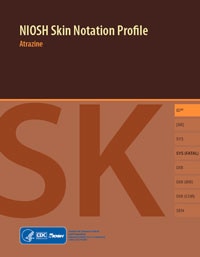NIOSH Skin Notation Profiles: Atrazine
January 2019
DHHS (NIOSH) Publication Number 2019-117

As the largest organ of the body, the skin performs multiple critical functions, such as serving as the primary barrier to the external environment. For this reason, the skin is often exposed to potentially hazardous agents, including chemicals, which may contribute to the onset of a spectrum of adverse health effects ranging from localized damage (such as irritant contact dermatitis and corrosion) to induction of immune-mediated responses (such as allergic contact dermatitis and pulmonary responses), or systemic toxicity (such as neurotoxicity and hepatotoxicity). Understanding the hazards related to skin contact with chemicals is a critical component of modern occupational safety and health programs.
This skin notation profile presents (1) a brief summary of epidemiological and toxicological data associated with skin contact with atrazine and (2) the rationale behind the hazard-specific skin notation (SK) assignment for atrazine. The SK assignment is based on the scientific rationale and logic outlined in the Current Intelligence Bulletin 61: A Strategy for Assigning New NIOSH Skin Notations [NIOSH 2009]. The summarized information and health hazard assessment are limited to an evaluation of the potential health effects of dermal exposure to atrazine. A literature search was conducted through February 2018 to identify information on atrazine, including but not limited to data relating to its toxicokinetics, acute toxicity, repeated-dose systemic toxicity, carcinogenicity, biological
system/function–specific effects (including reproductive and developmental effects and immunotoxicity), irritation, and sensitization.
NIOSH Skin Notation Profiles: Atrazine [PDF – 3 MB]
Suggested Citation
NIOSH [2019]. NIOSH skin notation profile: atrazine. By Hudson NL. Cincinnati, OH: U.S. Department of Health and Human Services, Centers for Disease Control and Prevention, National Institute for Occupational Safety and Health, DHHS (NIOSH) Publication No. 2019-117, DOI: https://doi.org/10.26616/NIOSHPUB2019117.
